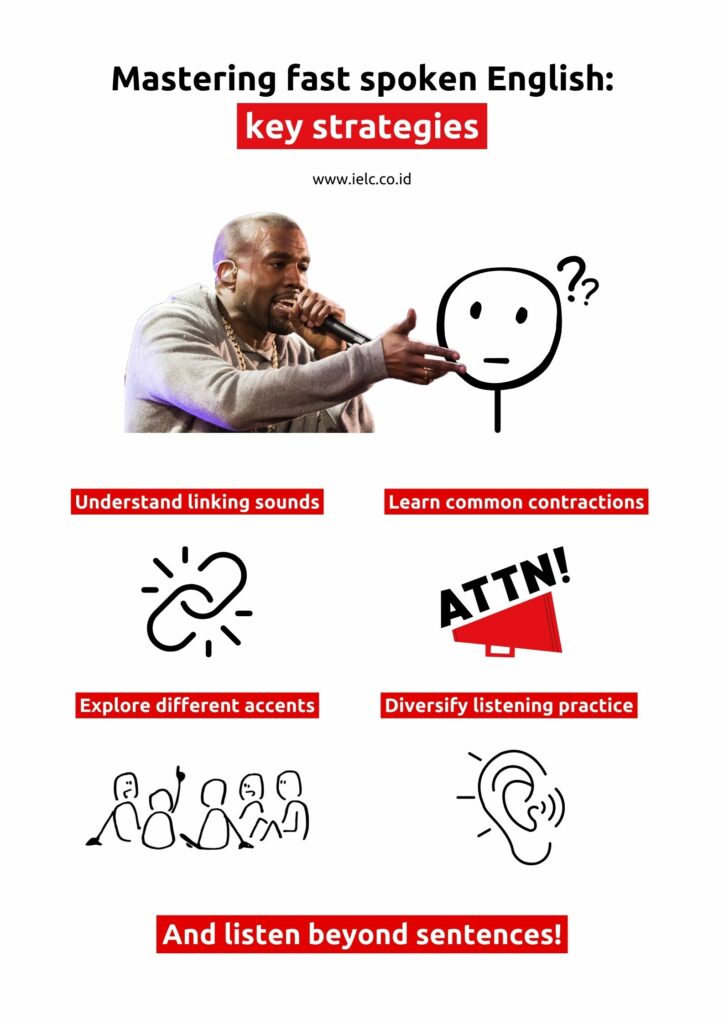
Why you can’t understand FAST spoken English
Welcome back, learners!
Ever found yourself comfortably following a TED talk but utterly lost in a casual, rapid-fire English conversation?
It’s like comfortably cruising on a bicycle, then suddenly trying to match pace with a racing car. You’re not alone if you’ve ever wondered why it’s easier to understand structured, slower speeches, but feel derailed when English goes off the rails at breakneck speed!
But why does this happen?
Why does our brain, which can follow complex ideas in a TED talk, start tripping over itself when English picks up speed in everyday conversations?
Well, buckle up! We’re about to embark on a journey into the world of fast spoken English. We’ll explore the intricacies of rapid conversations and, most importantly, arm you with the tools to not just survive but thrive in these linguistic fast lanes.
So, let’s turn the challenge of understanding fast-paced English into an exciting adventure. Ready, set, listen!

Why is it difficult to understand fast spoken English?
- Words get blurred: When English is spoken quickly, words tend to hold hands and dance together. This linking of sounds means that consonants and vowels cozy up, blurring the boundaries between words. This fluidity, while natural for native speakers, can be a maze for learners trying to catch every word.
- Contractions and colloqualisms: Conversational English loves to take shortcuts. Phrases like “gonna” and “wanna” are the norm in everyday talk, a far cry from the clear, textbook language you might be used to. These contractions and informal patterns are like local slang in a new city – familiar to residents but baffling to visitors!
- Diverse accents: English is spoken with a wide range of accents, each with its unique pronunciation and sometimes even vocabulary! When these accents are combined with fast speech, they introduce a set of sounds that might be new to your ears, making comprehension more challenging.
- Heavier cognitive workload: Processing a language that’s not your native tongue requires extra effort from your brain. When the speed of speech increases, so does this cognitive load, making real-time understanding and interpretation tougher.
- Real speech vs textbook speech: There’s often a gap between the neat, grammatically perfect sentences in learning materials and the messy reality of everyday speech. Real-life conversations are a mix of half-finished thoughts, interjections, and colloquialisms, which can throw you off if you’re expecting textbook-style dialogue.
- Idioms and slangs: Idioms and slang are staples in everyday English but can be hard to catch and understand when spoken quickly. They add color to the language but can be confusing without context or prior knowledge.
Understanding fast spoken English is like tuning into a new frequency. It’s challenging but not impossible. Recognizing these hurdles is the first step in adapting your listening strategies to catch the nuances of rapid English conversations. So, take a deep breath, and let’s dive into the world of fast English – it’s a wild ride, but oh so rewarding!
Now, let’s get right into the tips and tricks to understand fast spoken English better!
1. Diversify your listening practice
Alright, let’s jump into our first tip for mastering fast spoken English – diversifying your listening practice. Think of it as giving your ears a full workout by exposing them to different types of spoken English!
Sure, TED Talks and other well-articulated speeches are great for learning, but they’re just one piece of the puzzle. To really get a handle on fast spoken English, it’s essential to step into the world of unscripted content. This means tuning into reality shows, podcasts, and talk shows, where speech is more spontaneous and less polished.
When you listen to unscripted content, you’re immersing yourself in natural speech patterns that mirror everyday conversations. Unlike the polished, often rehearsed dialogue in scripted content, unscripted dialogue is spontaneous and raw. It’s packed with colloquialisms, slang, and idiomatic expressions – the real spices of English language that give it flavor and color!
One of the hallmark challenges of understanding fast spoken English is how words often blend together in rapid, connected speech. Regular exposure to this kind of speech in unscripted content is like training for a language marathon. It gradually builds your capability to parse and understand words that are spoken quickly and in succession.
Moreover, diving into unscripted content exposes you to a diverse array of speaking styles. You’ll hear different rates of speech, varying intonations, and a wide range of accents. This exposure is essential for tuning your ear to English as it’s spoken in the real world, beyond the controlled environment of a classroom or a scripted speech!
2. Understand linking sounds
Ready to dive into another exciting tip for mastering fast English? Let’s turn our ears to the magic of linking sounds!
Common linking sounds include consonant-to-vowel linking (where a word ending in a consonant is followed by a word starting with a vowel), vowel-to-vowel linking (where a word ending in a vowel is followed by a word starting with a vowel), and consonant-to-consonant linking. Each type has its own nuances in how the sounds blend together.
- Consonant-to-Vowel linking: This occurs when a word ending in a consonant sound is immediately followed by a word beginning with a vowel sound. The consonant sound smoothly transitions into the vowel, making the two words sound connected. For example, in the phrase “get it,” the ‘t’ from “get” smoothly transitions into the ‘i’ of “it,” making it sound almost like “getit.”
- Vowel-to-Vowel linking: This type of linking occurs when a word ending in a vowel sound is followed by a word starting with a vowel sound. In such cases, speakers often insert a slight ‘w’ or ‘y’ sound to make the transition smoother. For example, in the phrase “go away,” a ‘w’ sound naturally forms between ‘go’ and ‘away,’ making it sound like “gowaway.”
- Consonant-to-Consonant linking: This happens when words ending and starting with consonant sounds are joined. The sounds may blend together or be pronounced in a way that makes them flow smoothly. For example, in “best time,” the ‘t’ sound in “best” may blend with the ‘t’ in “time.”
In fast speech, these linking sounds become more pronounced, as speakers tend to run words together more fluidly. Understanding these patterns is crucial for comprehending fast-spoken English, as it helps in parsing what initially sounds like a continuous stream of speech into distinct words and phrases!
3. Learn common contractions
Think of contractions as the zesty spices of English conversation. They add flavor and speed to speech, making it breezy and informal. Native speakers use these almost instinctively, especially when they’re in a relaxed mode of chatting.
Here’s a rundown of some everyday contractions you’re likely to encounter in casual English:
- Gonna: The relaxed cousin of “going to.”
- Wanna: The swift alternative to “want to.”
- Gotta: “Got to” in its breeziest form.
- Ain’t: A versatile contraction for various negations.
- Lemme: The quicker version of “let me.”
- Gimme: “Give me” with a casual spin.
- Dunno: The laid-back rendition of “don’t know.”
To familiarize yourself with these contractions, immerse in real-world English – think movies, TV shows, casual chit-chat, and the vibrant world of social media. The key here is repeated exposure; the more you hear these contractions, the more naturally they’ll come to you!
But, don’t just listen – try using these contractions in your speech. It’s like dressing up your English in a more conversational outfit. Practicing these contractions can elevate your fluency and give your English a more natural, colloquial edge!
4. Listen beyond sentences
In everyday speech, people often don’t speak in perfectly structured sentences. Conversations can be fragmented. Sometimes people start a thought and then shifting to another without completing the first one! For those used to the clear-cut sentences of written language, this can be a bit of a maze.
Understanding spoken English, especially when it’s fast and informal, is about tuning into context and non-verbal cues. Gestures, facial expressions, and tone of voice are like subtitles to what’s being said. They fill in the gaps, helping you grasp the essence of the conversation!
In casual chats, fillers like “um,” “uh,” or “you know” pepper the speech. They’re like little pauses, giving the speaker a moment to think. Recognizing these as part of natural speech helps you stay on track, without getting thrown off by these conversational quirks.
Good listeners often use predictive skills to anticipate where a speaker is going with their thoughts, even if they don’t speak in complete sentences. This skill involves using context, previous knowledge, and the speaker’s cues to predict and understand the message.
To get better at this, dive into unscripted content – think podcasts, interviews, and everyday dialogues. This exposure is your training ground for getting used to the rhythm and patterns of real spoken English!
5. Explore different accents
Are you ready for our final tip on mastering the understanding of fast-spoken English? It’s time to embark on an exciting journey through the diverse world of English accents!
English is a global language, and with that comes a beautiful spectrum of accents, each singing its own melody. From the rolling Rs of Scottish English to the melodious lilt of Irish English or the vibrant vibes of Australian English, each accent adds a unique color to the tapestry of spoken English.
Accents are more than just sounds; they’re windows into cultures. By exploring these accents, you’re not just learning new ways to speak; you’re getting insights into the lives, histories, and souls of different communities. This enriches your language journey, making it a more profound and personal experience!
Think of accents as a gym for your ears and tongue. Tuning into different accents hones your ability to detect and replicate diverse pronunciation patterns. This not just polishes your speaking skills but also elevates your ability to understand and process spoken English in all its forms.
Focusing on accents trains your ear to catch the subtle nuances in speech. This skill is crucial for differentiating between similar sounds and truly grasping what native speakers are saying, especially when they’re speaking quickly or using colloquial language.
By familiarizing yourself with a variety of accents, you’re gearing up for real-life conversations where diverse speaking styles are the norm. This preparation is key to navigating the world with confidence and ease, ready to interact and communicate effectively in any setting!
At IELC, we teach English the right way
Our goal is to get you speaking in English with fluency and confidence as fast as possible. We want to give you the skills you need to fulfil your potential!
Our experienced teachers will guide you along every step of the learning process to ensure that you are not wasting your time, money, and energy on useless language exercises & wrong methods.
Our courses
With our modern campus and technology, we are equipped to provide the best possible courses for children, teens, and adults, including:
Online and on campus IELTS courses
Online and on campus TOEFL PBT courses
Online and on campus TOEFL iBT courses
We offer our classes in group classes or private classes.
No matter what your goals are, our team will help you achieve these goals by providing you with Indonesia’s best English courses!
Talk to our team today to get your FREE consultation and take your first step towards success.
Sincerely,

IELC Academic Director
